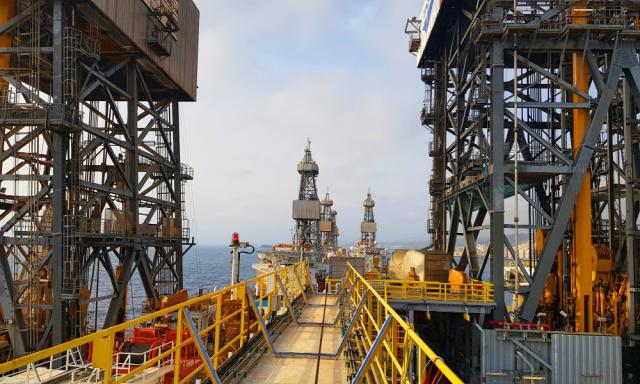
(Source: Shutterstock.com)
An unwillingness to invest in long-cycle projects and distaste for long-term contracts by some oil and gas companies are adding to the woes of a battered offshore drilling sector. Tack on to that an oversupply of floaters along with a sputtering, cash-deprived exploration segment, a stalled oil demand recovery and less spending by everyone in the business.
Long story short, “the next two years look extremely challenging” for offshore drillers, Lars Eirik Nicolaisen, senior partner and deputy CEO at Rystad Energy, said during a webinar this week.
Negative cash flows of some offshore drilling companies could lead to an inability to pay down debt, ultimately enabling consolidation with only the strongest surviving, he said. Which companies come out on top are likely those with the most attractive restructured balance sheets.
Offshore drillers are again facing strong headwinds. Among these is what Nicolaisen called “long-cycle discrimination,” a structural headwind that is facing the floater market in particular. He pointed out how conventional exploration budgets, which rely mostly on cash flow from operations, continued to fall even as some operators’ cash flows picked up. Exploration is perhaps one of the most long-cycle activities an oil company can do; however, there is “lack of willingness to deploy capex into these long cycle projects.”
Oil companies have reduced activity and cut spending—by an average 28% based on Rystad’s analysis—amid weak oil prices, an oversupply of resources and slowing demand.
Rystad forecasts oil demand will drop by 11.5% in 2020, or 11.4 MMbbl/d, to 88.1 MMbbl/d this year. Estimates show oil demand in 2019 was about 99.5 MMbbl/d.
“Oil companies no longer want to enter long-term contracts,” he said, adding this “creates a very steep forward utilization curve—a key weakness.”
In 2019, the drillship spot utilization was 71%. Looking at forward utilization, rolling forward the backlog of current contracts and gauging utilization if no new contracts were entered, the percentage drops to 40% in a year and 22% by 2022, Rystad’s data show.
Fragmentation is another headwind the offshore drilling sector is facing on the customer and supplier sides, Nicolaisen said.
“In 2014, we had 65 E&P companies around the world contracting floating drilling capacity,” he said. “Fast forward to 2016 and the number was 35. Fast forward to 2020 and we have 30 E&Ps that are contracting floating drilling capacity. Of those 30, 11 companies are contracting ultradeepwater drillships.”
He noted of the current 33 suppliers, 11 offer ultradeepwater drillships. That’s one floating drilling supplier per customer.
“This is what we mean by fragmentation, and this is a key concern for the industry,” he said, adding this sets the stage for consolidation.
Weak oil prices, though slowly improving, is not helping much today.
“Offshore projects tend to require north of $45, $50, even up to $60 in order to be viable investments,” he said. “We’re not going to see those kinds of oil prices before we go into 2022.”
Meanwhile, E&Ps budgets continue to shrink. With fewer jobs, rig fleets are getting smaller.
“Since March 2020, the industry has reaccelerated the attrition numbers and we have taken out 15 units out of the supply stack,” Nicolaisen said. “We are now starting to eat into the higher end of the feet, meaning that 6th and 7th generation units are now also victims for attrition. We believe that this will continue to unfold as the industry restructures over the next two years.”
Many rig contractors are operating at a loss, with varying amounts of cash on balance sheets, which puts them on the path toward restructuring, according to Nicolaisen.
“I think it’s a fair statement to say that most of the names in this industry will not be able to address and comply with their cost of capital and debt repayment schedules,” he said. This sets the stage for restructuring of balance sheets” with consolidation being the key to address some headwinds.
Other factors that can strengthen an offshore driller’s competitiveness includes established driller-operator relationships and rig technology sophistication and capabilities.
Rystad believes four companies are best positioned to survive: Transocean Ltd., Valaris Plc, Diamond Offshore Drilling Inc. and Maersk Drilling AS.
Nicolaisen singled out Transocean’s customer relationship, strong backlog and high-graded fleet with scale.
Formed in 2019 by the merger of Ensco Plc and Rowan Cos. Plc, Valaris drove consolidation in the offshore drilling space. Ensco acquired Atwood Oceanics Inc. in 2017. Nicolaisen, however, pointed out that Valaris must address its balance sheet before moving into a consolidating position.
Diamond Offshore, which filed for bankruptcy in April, is addressing its balance sheet, which means “they are in pole position,” Nicolaisen said, later highlighting its strong innovation portfolio and marketing team. “They will maybe be the first one out of restructuring and as such be well equipped to be consolidators”
He called Maersk Drilling another obvious survivor, given its runway, strong balance sheet and innovation.
“A fascinating feature about these companies is their debt burden and arguing for a restructuring of that debt,” Nicolaisen added. “Essentially, what we are arguing is that debt will be converted into equity, which in turn means that current debt owners will become equity owners of these companies.”
Overlap here could lead to further consolidation, according to Rystad.
Recommended Reading
SLB’s ChampionX Acquisition Key to Production Recovery Market
2024-04-21 - During a quarterly earnings call, SLB CEO Olivier Le Peuch highlighted the production recovery market as a key part of the company’s growth strategy.
PHX Minerals’ Borrowing Base Reaffirmed
2024-04-19 - PHX Minerals said the company’s credit facility was extended through Sept. 1, 2028.
BP Restructures, Reduces Executive Team to 10
2024-04-18 - BP said the organizational changes will reduce duplication and reporting line complexity.
Matador Resources Announces Quarterly Cash Dividend
2024-04-18 - Matador Resources’ dividend is payable on June 7 to shareholders of record by May 17.
EQT Declares Quarterly Dividend
2024-04-18 - EQT Corp.’s dividend is payable June 1 to shareholders of record by May 8.






